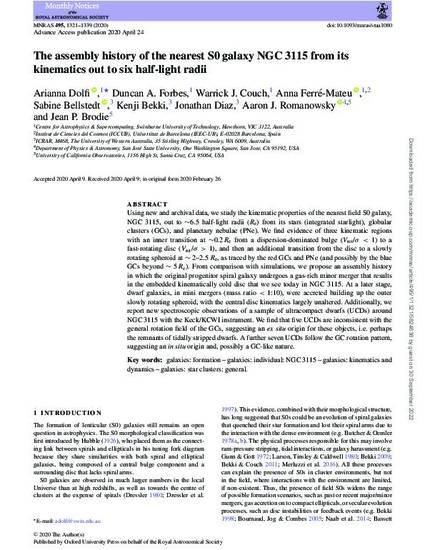
Using new and archival data, we study the kinematic properties of the nearest field S0 galaxy, NGC 3115, out to ∼6.5 half-light radii (Re) from its stars (integrated starlight), globular clusters (GCs), and planetary nebulae (PNe). We find evidence of three kinematic regions with an inner transition at ∼0.2 Re from a dispersion-dominated bulge (Vrot/σ < 1) to a fast-rotating disc (Vrot/σ > 1), and then an additional transition from the disc to a slowly rotating spheroid at ∼ 2-2.5Re, as traced by the red GCs and PNe (and possibly by the blue GCs beyond ∼ 5Re). From comparison with simulations, we propose an assembly history in which the original progenitor spiral galaxy undergoes a gas-rich minor merger that results in the embedded kinematically cold disc that we see today in NGC 3115. At a later stage, dwarf galaxies, in mini mergers (mass ratio < 1:10), were accreted building up the outer slowly rotating spheroid, with the central disc kinematics largely unaltered. Additionally, we report new spectroscopic observations of a sample of ultracompact dwarfs (UCDs) around NGC 3115 with the Keck/KCWI instrument.We find that five UCDs are inconsistent with the general rotation field of the GCs, suggesting an ex situ origin for these objects, i.e. perhaps the remnants of tidally stripped dwarfs. A further seven UCDs follow the GC rotation pattern, suggesting an in situ origin and, possibly a GC-like nature.
- Galaxies: Formation,
- Galaxies: Individual: NGC 3115,
- Galaxies: Kinematics and dynamics,
- Galaxies: Star clusters: General
Available at: http://works.bepress.com/aaron_romanowsky/179/

This article has been accepted for publication in Monthly Notices of the Royal Astronomical Society ©: 2020 The Author(s) Published by Oxford University Press on behalf of the Royal Astronomical Society. All rights reserved.